Employing Theatrical Techniques in Documentary Film
DOI:
https://doi.org/10.24193/subbdrama.2025.1.06Keywords:
theatre, documentary, social impact, trauma representation, history revisitedAbstract
This paper examines the intersection between documentary filmmaking and theatre, arguing that this fusion transcends traditional objective representations of reality. By incorporating elements of theatre, such as narrative structure, performance, and audience interaction, documentaries can offer deeper, more artistic explorations of complex realities and the human condition. Through the analysis of several films that exemplify this approach, the study demonstrates how theatrical techniques in documentary not only broaden the genre’s artistic possibilities but also provide unique insights into historical, social, and personal contexts. This approach transforms documentaries into powerful tools for emotional and intellectual engagement, capturing the transformative journey of performers and their impact on both the film’s subject and the audience, ultimately expanding the scope of documentary filmmaking.
References
Bleeker, Maaike. Performance and Phenomenology: Traditions and Transformations. London: Routledge, 2015.
Bogart, Anne. “Theatre and Trauma: Performance in the Aftermath of Violence.” Performance Studies Quarterly 1, no. 2 (2015): 110-123.
De Jongh, Nicholas. “Documentary, Theatre and the Politics of Memory: Revisiting Historical Traumas.” Theatre Journal 65, no. 4 (2013): 501-515.
Leahy, Thomas. “Documentary Performance: The Transformation of the Real through Rehearsals.” Theatre Research International 45, no. 3 (2020): 267-281.
McNamara, J. A. “The Documentary Turn in Performance.” Performance Studies Review 15, no. 3 (2010): 200-214.
Nichols, Bill, Documentary Theory and Practice. 2nd ed. Los Angeles: SAGE Publications, 2017.
Radstone, Susannah. “Performing Documentary: The Blurring of Boundaries between Fact and Fiction in Documentary Film.” The Journal of Aesthetics and Art Criticism 70, no. 4 (2012): 497-509.
Russo, Linda. “Fabio Cavalli and the incredible power of theatre in prison”, October 9, 2023, https://www.spazio50.org/fabio-cavalli-e-lincredibile-potenza-del-teatro-in-carcere/
Thomson, Patricia. “The Bard Behind Bars.” American Cinematographer, February 2013.
Winston, Brian, The Documentary Film Book. London: British Film Institute, 2013.
Films
Niewiera, Elwira, and Piotr Rosolowski, Hamlet Syndrome (Syndrom Hamleta). 2022.
Slijepcević, Nebojsa, Srbenka. 2018.
Taviani, Paolo, and Vittorio Taviani, Cesar Must Die (Cesare deve morire). 2012.
Mihăilescu, Sebastian, For Me You Are Ceausescu (Pentru mine tu ești Ceaușescu). 2021.
Solomon, Alexandru, Arsenie. An Amazing Afterlife (Arsenie. Viața de apoi). 2023.
Downloads
Published
How to Cite
Issue
Section
License
Copyright (c) 2025 Studia Universitatis Babeș-Bolyai Dramatica

This work is licensed under a Creative Commons Attribution-NonCommercial-NoDerivatives 4.0 International License.


